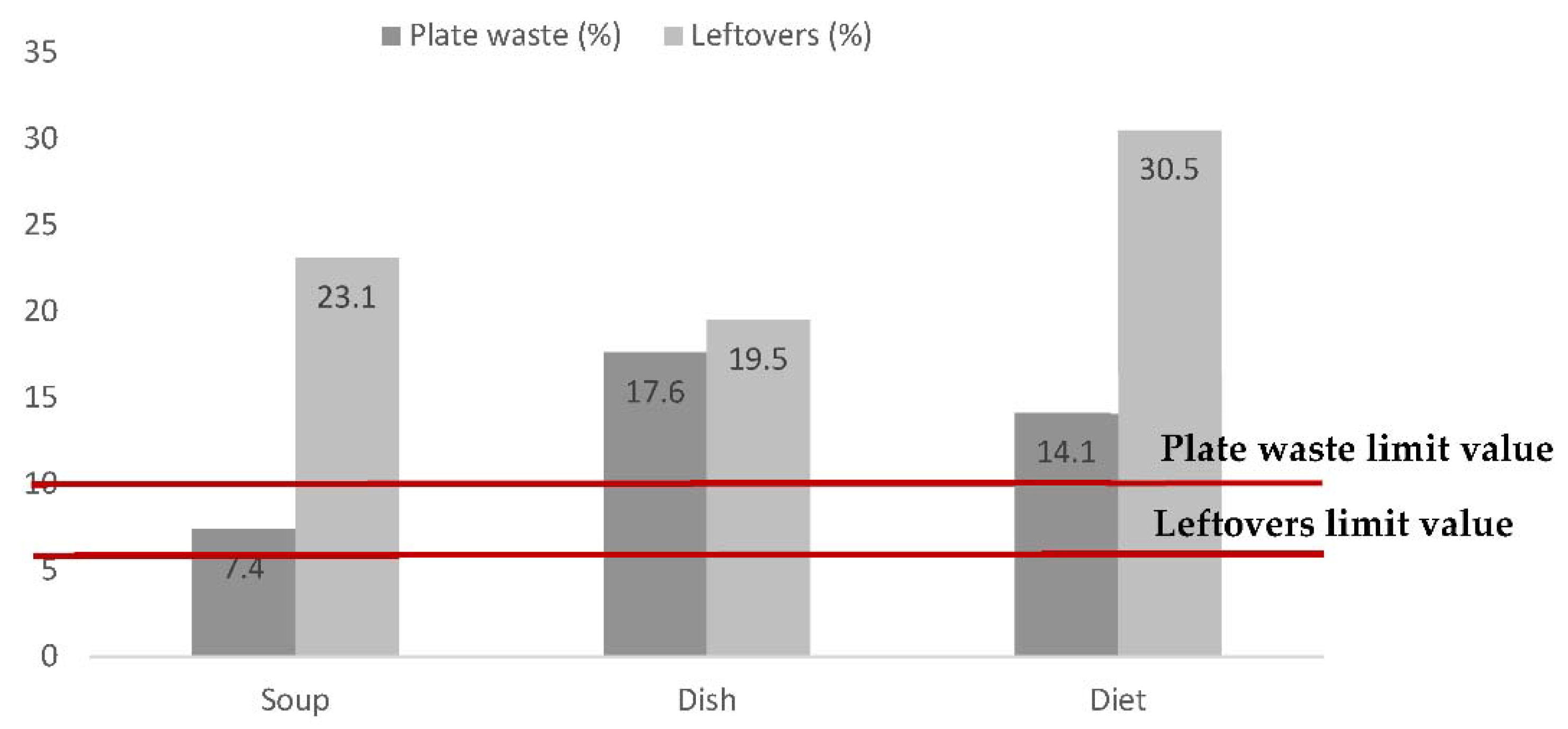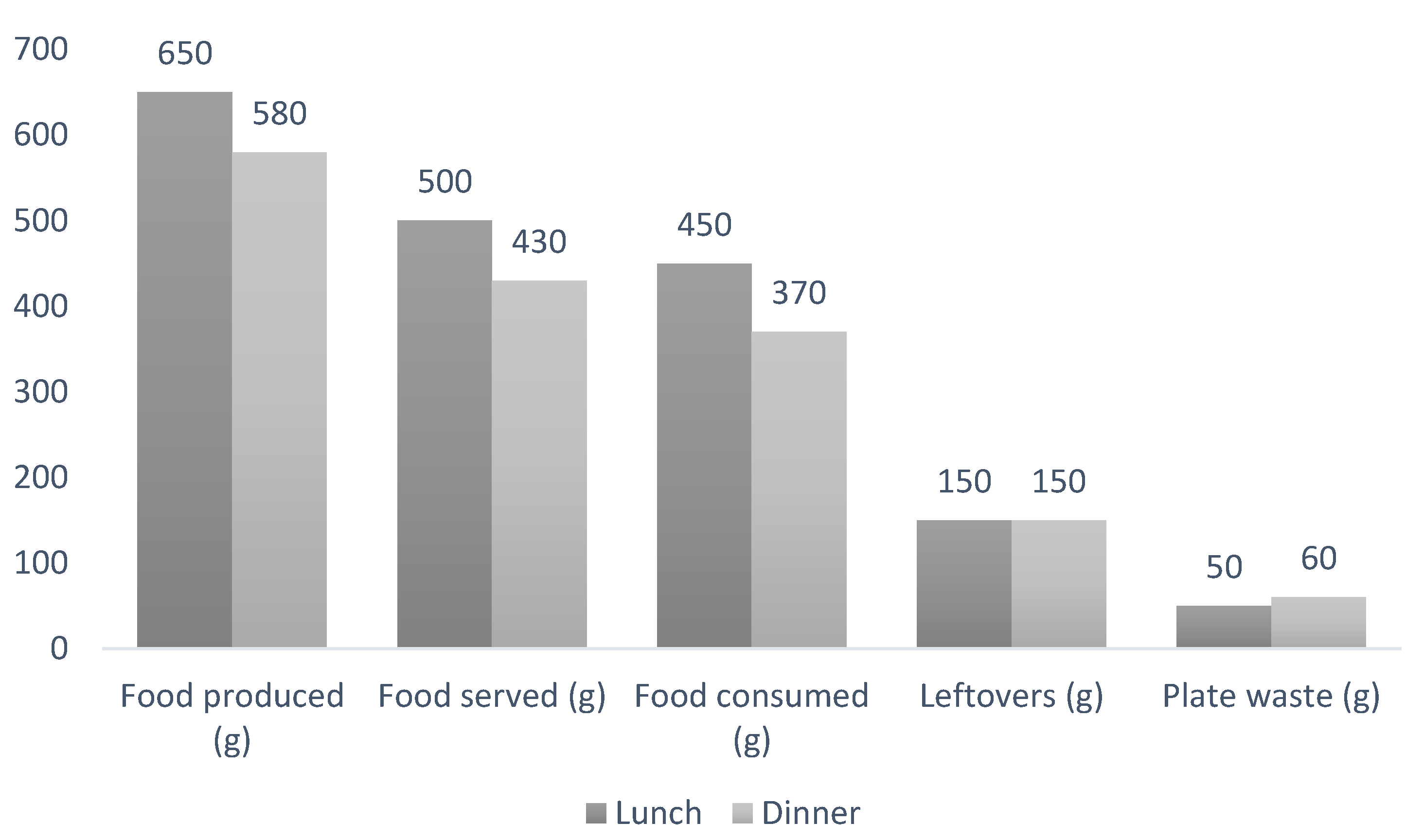Evaluation of Food Waste at a Portuguese Geriatric Institution
Abstract
1. Introduction
2. Materials and Methods
3. Results
3.1. Food Produced, Served, Consumed and Wasted
3.2. Food Waste—Social and Economic Impact
4. Discussion
5. Conclusions
Author Contributions
Funding
Institutional Review Board Statement
Informed Consent Statement
Acknowledgments
Conflicts of Interest
References
- Instituto Nacional de Estatística (INE). Projeções de População Residente em Portugal 2008–2060. 2009. Available online: https://www.ine.pt/ (accessed on 14 March 2020).
- Instituto Nacional de Estatística (INE). Estatísticas de Portugal. Recenseamento da População e Habitação—Census 2011. 2012. Available online: http://censos.ine.pt (accessed on 4 January 2021).
- Hansen, K.V. Food and meals in caring institutions—A small dive into research. Int. J. Health Care Qual. Assur. 2016, 29, 380–406. [Google Scholar] [CrossRef]
- Sellier, C. Malnutrition in the elderly, screening and treatment. Soins Gerontol. 2018, 23, 12–17. [Google Scholar] [CrossRef] [PubMed]
- Iuliano, S.; Olden, A.; Woods, J. Meeting the nutritional needs of elderly residents in aged-care: Are we doing enough? J. Nutr. Health Aging 2013, 17, 503–508. [Google Scholar] [CrossRef] [PubMed]
- Lee, K.H.; Mo, J. The Factors Influencing Meal Satisfaction in Older Adults: A Systematic Review and Meta-analysis. Asian Nurs. Res. (Korean Soc. Nurs. Sci.) 2019, 13, 169–176. [Google Scholar] [CrossRef]
- Williams, P.; Walton, K. Plate waste in hospitals and strategies for change. Eur. J. Clin. Nutr. Met. 2011, 6, 235–241. [Google Scholar] [CrossRef]
- McAdams, B.; von Massow, M.; Gallant, M. Food Waste and Quality of Life in Elderly Populations Living in Retirement Living Communities. J. Hous. Elder. 2018, 33, 1–13. [Google Scholar] [CrossRef]
- Simzari, K.; Vahabzadeh, D.; Nouri Saeidlou, S.; Khoshbin, S.; Bektas, Y. Food intake, plate waste and its association with malnutrition in hospitalized patients. Nutr. Hosp. 2017, 34, 1376–1381. [Google Scholar] [PubMed]
- Keller, H.H.; Carrier, N.; Slaughter, S.E.; Lengyel, C.; Steele, C.M.; Duizer, L.; Morrison, J.; Brown, K.S.; Chaudhury, H.; Yoon, M.N.; et al. Prevalence and Determinants of Poor Food Intake of Residents Living in Long-Term Care. J. Am. Med. Dir. Assoc. 2017, 18, 941–947. [Google Scholar] [CrossRef]
- Stroebele-Benschop, N.; Depa, J.; de Castro, J.M. Environmental Strategies to Promote Food Intake in Older Adults: A Narrative Review. J. Nutr. Gerontol. Geriatr. 2016, 35, 95–112. [Google Scholar] [CrossRef]
- Whitelock, E.; Ensaff, H. On Your Own: Older Adults’ Food Choice and Dietary Habits. Nutrients 2018, 10, 413. [Google Scholar] [CrossRef]
- Oliveira, D.; Liz Martins, M.; Rocha, A. Food waste index as an indicator of menu adequacy and acceptability in a Portuguese mental health hospital. Acta Portuguesa Nutrição 2020, 20, 14–18. (In Portuguese) [Google Scholar]
- Wilson, E.D.; Garcia, A.C. Environmentally friendly health care food services: A survey of beliefs, behaviours, and attitudes. Can. J. Diet. Pract. Res. 2011, 72, 117–122. [Google Scholar] [CrossRef]
- Schiavone, S.; Pelullo, C.P.; Attena, F. Patient Evaluation of Food Waste in Three Hospitals in Southern Italy. Int. J. Environ. Res. Public Health 2019, 16, 4330. [Google Scholar] [CrossRef] [PubMed]
- Ferreira, M.; Liz Martins, M.; Rocha, A. Food waste as an index of foodservice quality. Br. Food J. 2013, 115, 1628–1637. [Google Scholar] [CrossRef]
- Betz, A.; Buchli, J.; Gobel, C.; Muller, C. Food waste in the Swiss food service industry—Magnitude and potential for reduction. Waste Manag. 2015, 35, 218–226. [Google Scholar] [CrossRef]
- Dias-Ferreira, C.; Santos, T.; Oliveira, V. Hospital food waste and environmental and economic indicators—A Portuguese case study. Waste Manag. 2015, 46, 146–154. [Google Scholar] [CrossRef] [PubMed]
- Food and Agriculture Organization of the United Nations. The State of Food and Agriculture—Moving forward on Food Loss and Waste Reduction; FAO: Rome, Italy, 2019. [Google Scholar]
- Garcia-Herrero, L.; De Menna, F.; Vittuari, M. Food waste at school. The environmental and cost impact of a canteen meal. Waste Manag. 2019, 100, 249–258. [Google Scholar] [CrossRef]
- Ishangulyyev, R.; Kim, S.; Lee, S.H. Understanding Food Loss and Waste-Why Are We Losing and Wasting Food? Foods 2019, 8, 297. [Google Scholar] [CrossRef] [PubMed]
- Eriksson, M.; Persson Osowski, C.; Malefors, C.; Bjorkman, J.; Eriksson, E. Quantification of food waste in public catering—A case study from a Swedish municipality. Waste Manag. 2017, 61, 415–422. [Google Scholar] [CrossRef]
- Liz Martins, M.; Rodrigues, S.S.; Cunha, L.M.; Rocha, A. School lunch nutritional adequacy: What is served, consumed and wasted. Public Health Nutr. 2020, 1–9. [Google Scholar] [CrossRef] [PubMed]
- Conselho Federal de Nutricionistas. Resolução CFN N° 380/2005; CFN: Brasília, Brazil, 2005. [Google Scholar]
- NHSE Hospitality. Managing Food Waste in the NHS; Department of Health: Leeds, UK, 2005. [Google Scholar]
- Carr, D.; Levins, J. Plate Waste Studies. Available online: http://www.nfsmi.org/Information/recipes4.pdf (accessed on 20 October 2020).
- Liz Martins, M.; Rodrigues, S.S.P.; Cunha, L.M.; Rocha, A. Factors influencing food waste during lunch of fourth-grade school children. Waste Manag. 2020, 113, 439–446. [Google Scholar] [CrossRef] [PubMed]
- Stanga, Z.; Zurfluh, Y.; Roselli, M.; Sterchi, A.B.; Tanner, B.; Knecht, G. Hospital food: A survey of patients’ perceptions. Clin. Nutr. 2003, 22, 241–246. [Google Scholar] [CrossRef]
- United Nations. Resolution Adopted by the General Assembly 70/1. Transforming Our World: The 2030 Agenda for Sustainable Development; UN: New York, NY, USA, 2015. [Google Scholar]


| Food Produced (kg) | Food Served (kg) | Food Consumed (kg) | Leftovers (kg) | Plate Waste (kg) | Leftovers (%) | Plate Waste (%) | ||
|---|---|---|---|---|---|---|---|---|
| Soup (n = 29) | Mean | 37.3 | 28.6 | 26.5 | 8.6 | 2.1 | 23.1 | 7.4 |
| SD | 3.2 | 2.6 | 2.4 | 1.7 | 0.4 | 4.0 | 1.4 | |
| Maximum | 46.7 | 36.4 | 33.5 | 10.5 | 2.9 | 27.8 | 9.3 | |
| Minimum | 34.7 | 36.4 | 24.6 | 4.2 | 1.3 | 12.2 | 4.7 | |
| Main Dish (n = 29) | Mean | 24.2 | 18.7 | 15.4 | 5.5 | 3.3 | 19.5 | 17.6 |
| SD | 10.3 | 5.3 | 4.6 | 6.2 | 1.3 | 11.3 | 5.0 | |
| Maximum | 65.6 | 35.0 | 29.8 | 30.6 | 5.8 | 48.8 | 27.5 | |
| Minimum | 8.8 | 7.4 | 6.7 | 0.7 | 0.7 | 3.3 | 9.2 | |
| Diet Dish (n = 20) | Mean | 3.6 | 2.4 | 2.1 | 1.2 | 0.4 | 30.5 | 14.1 |
| SD | 1.8 | 1.08 | 0.9 | 0.9 | 0.3 | 11.2 | 8.1 | |
| Maximum | 7.5 | 4.5 | 3.7 | 3.0 | 1.0 | 57.1 | 30.9 | |
| Minimum | 1.56 | 0.67 | 0.56 | 0.31 | 0.0 | 14.7 | 0.0 | |
| Food Produced (kg) | Leftovers (kg) | Leftovers (%) | Plate Waste (kg) | Plate Waste (%) | |
|---|---|---|---|---|---|
| Meat dishes (n = 24) | 338.1 | 79.9 | 23.6 | 43.0 | 16.6 |
| Fish dishes (n = 21) | 330.5 | 81.1 | 24.5 | 47.5 | 19.0 |
| p-value * | 0.75 | 0.16 | 0.03 |
| Food Waste | Total Food Waste (kg) | Food Waste Per Capita (kg) | Nº of Older Adults That Could Be Fed | Cost (Euros) | ||
|---|---|---|---|---|---|---|
| Study Period | During One Month | During One Year | ||||
| Plate waste | 166.1 | 0.05 | 406 | 1219.3 | 2438.6 | 29,262.6 |
| Leftovers | 441.9 | 0.15 | 1081 | 3243.7 | 6487.5 | 77,849.8 |
| Total | 608.0 | 0.20 | 1487 | 4463.0 | 8926.0 | 107,112.4 |
Publisher’s Note: MDPI stays neutral with regard to jurisdictional claims in published maps and institutional affiliations. |
© 2021 by the authors. Licensee MDPI, Basel, Switzerland. This article is an open access article distributed under the terms and conditions of the Creative Commons Attribution (CC BY) license (http://creativecommons.org/licenses/by/4.0/).
Share and Cite
Liz Martins, M.; Henriques, A.S.; Rocha, A. Evaluation of Food Waste at a Portuguese Geriatric Institution. Sustainability 2021, 13, 2452. https://doi.org/10.3390/su13052452
Liz Martins M, Henriques AS, Rocha A. Evaluation of Food Waste at a Portuguese Geriatric Institution. Sustainability. 2021; 13(5):2452. https://doi.org/10.3390/su13052452
Chicago/Turabian StyleLiz Martins, Margarida, Ana Sofia Henriques, and Ada Rocha. 2021. "Evaluation of Food Waste at a Portuguese Geriatric Institution" Sustainability 13, no. 5: 2452. https://doi.org/10.3390/su13052452
APA StyleLiz Martins, M., Henriques, A. S., & Rocha, A. (2021). Evaluation of Food Waste at a Portuguese Geriatric Institution. Sustainability, 13(5), 2452. https://doi.org/10.3390/su13052452







